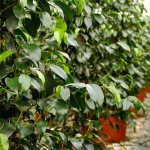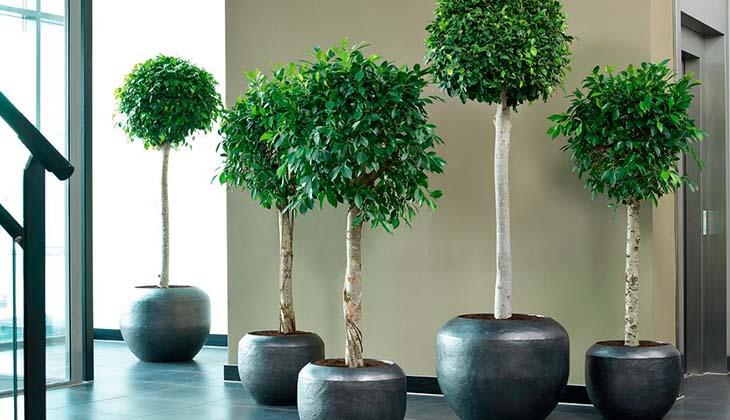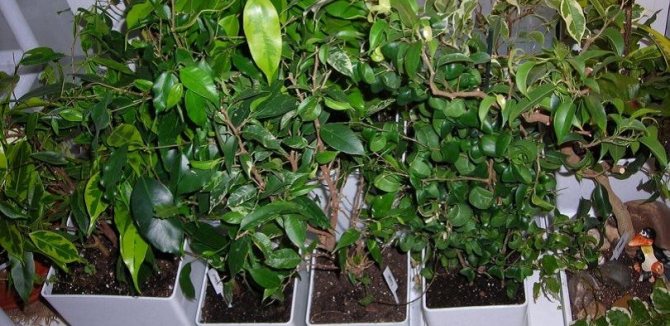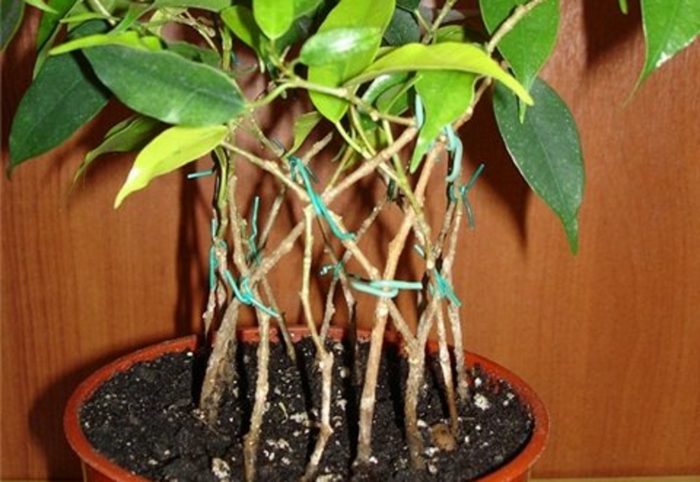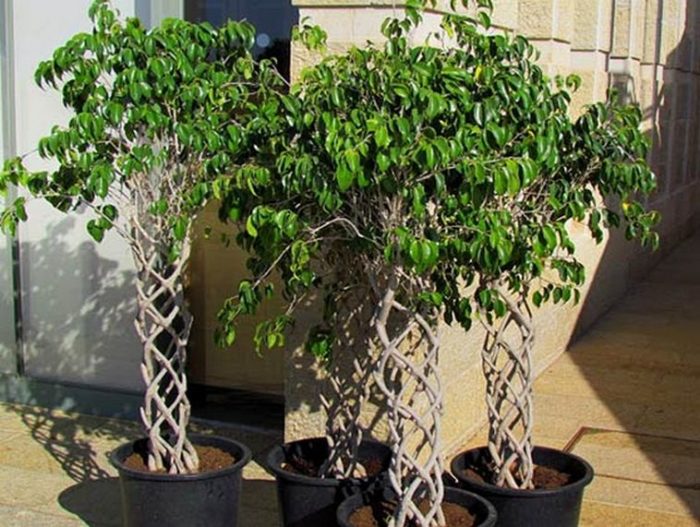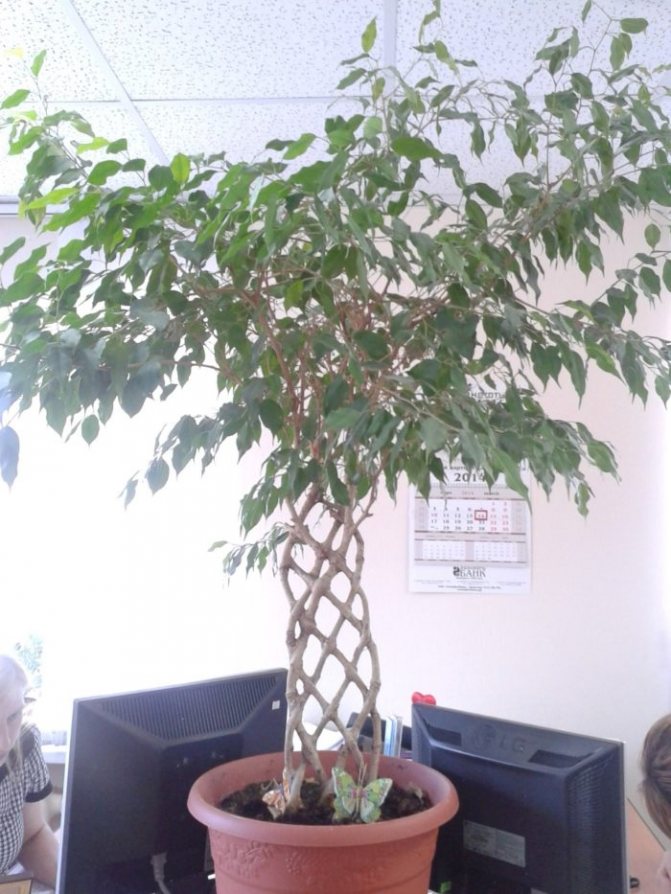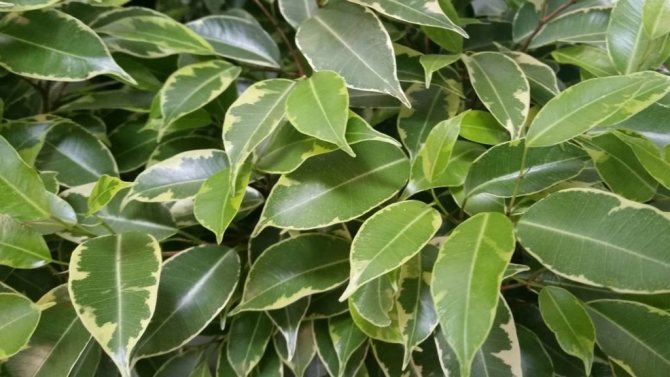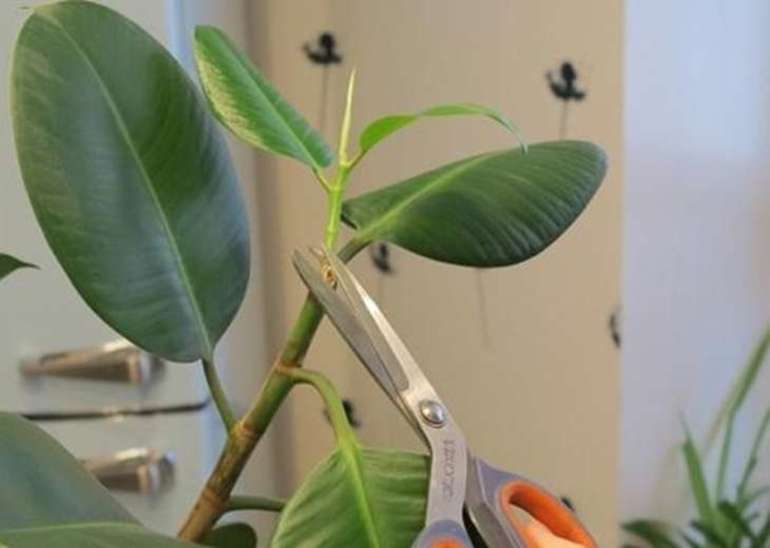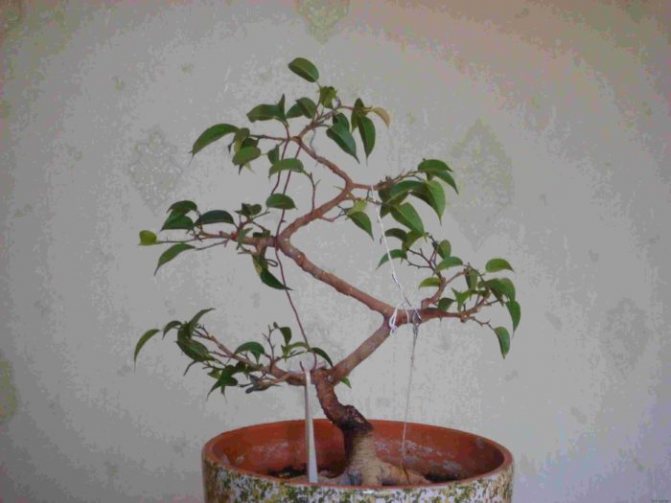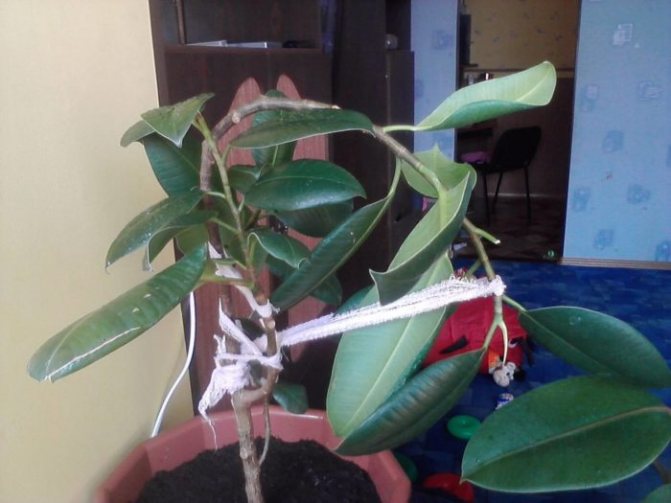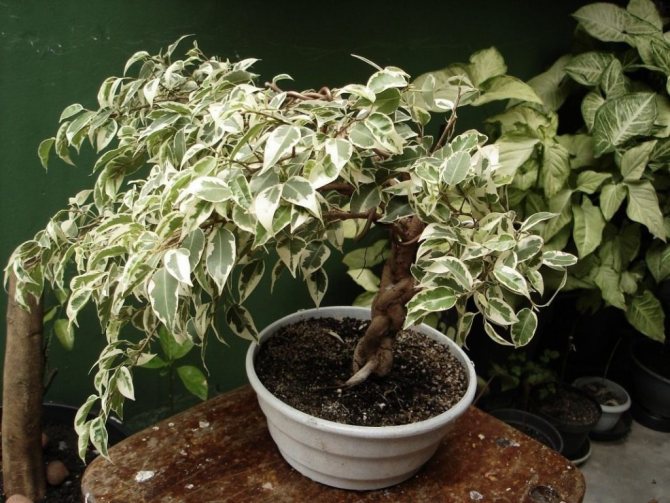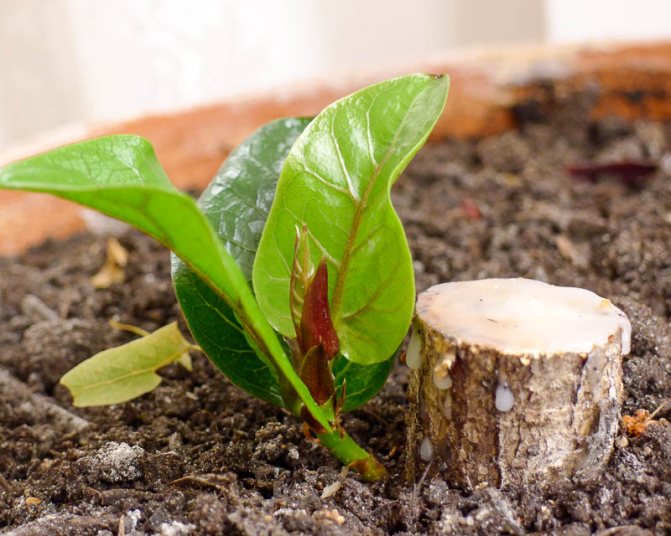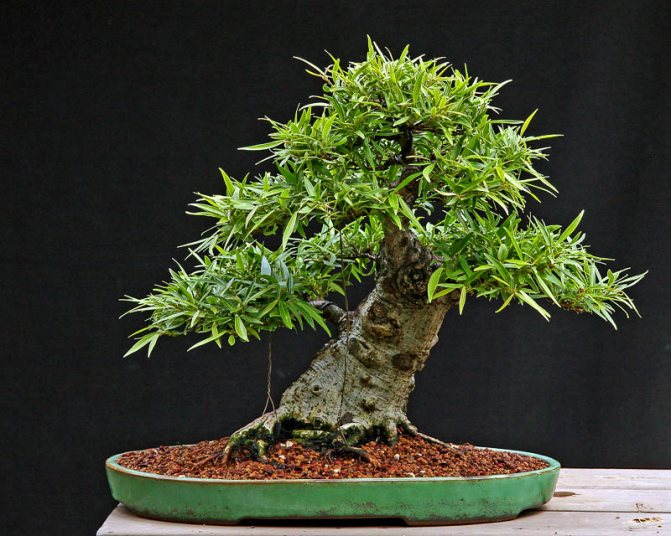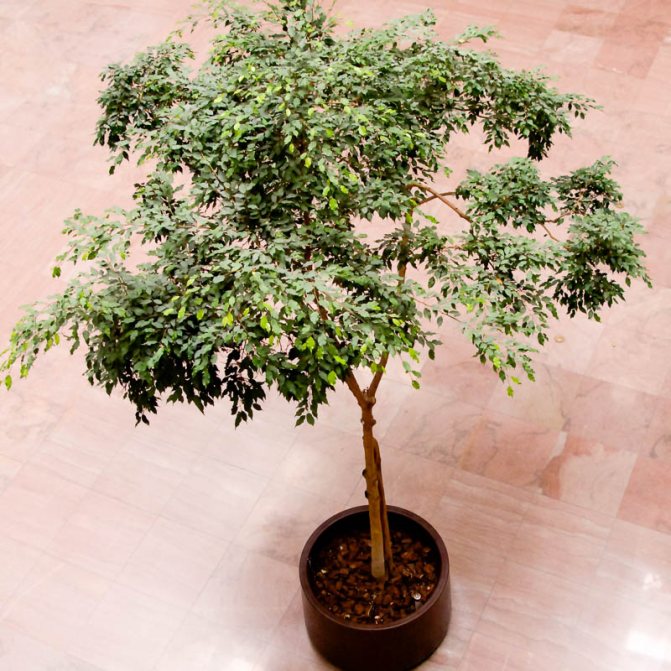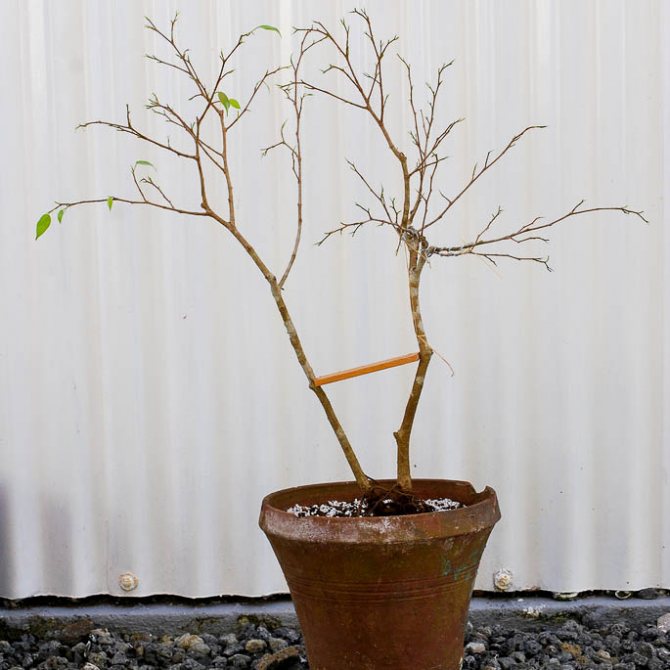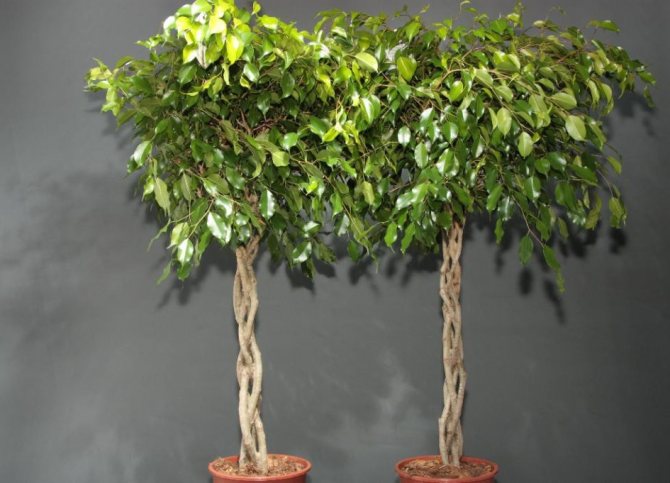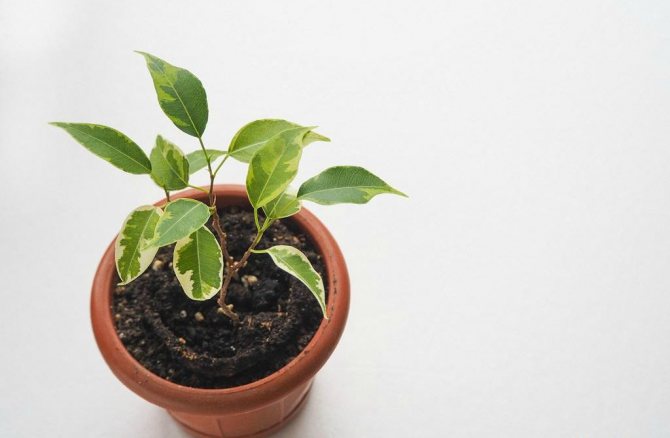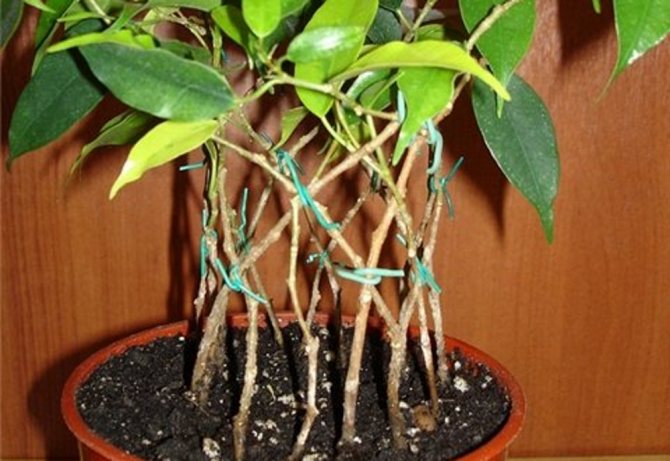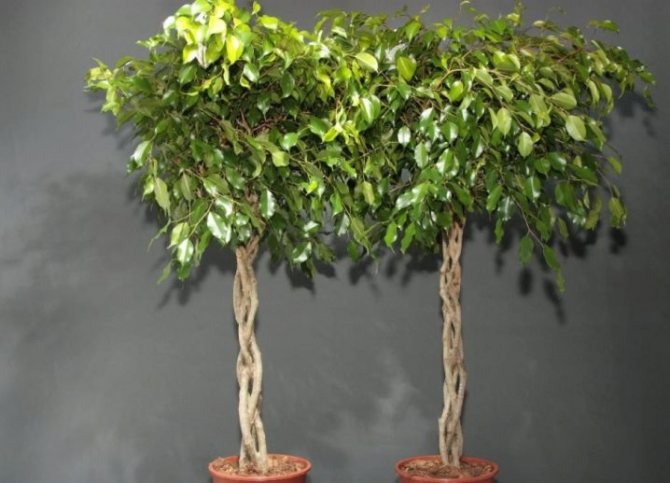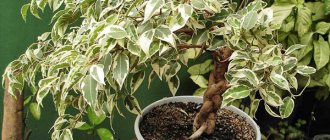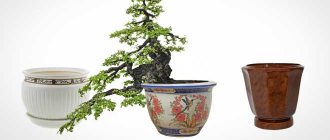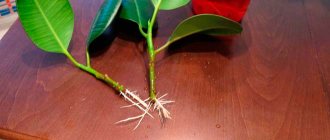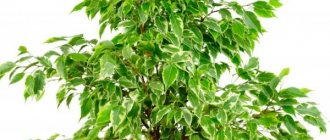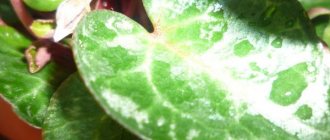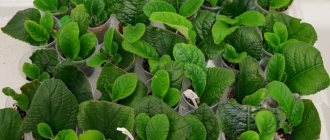Ficus with a beautifully formed crown will decorate any interior. Ficus crown formation is simply necessary for indoor cultivation.
To prevent the crown of the ficus from looking one-sided, do not forget about lighting.
Some types of ficuses can be grown in the form of a trunk or a small tree, in which two-thirds of the trunk is free of branches.
Some types of ficuses with a flexible stem can be planted 2-4 in one pot to give them a vertical shape. As they grow, the stems of the ficus need to be intertwined, and over time they even grow together.
The shoots are allowed to grow to the desired height, after which the tops are pinched, and a lush crown is formed on top, which can be formed in the form of a sphere, hemisphere, or give it any other shape.
The first days at home
Before bringing home a plant, you should clearly determine its location - Benjamin's ficus is extremely difficult to endure changing places, and most often, as a result of moving, it sheds its leaves.
If this happens at the first time after the purchase, then you should not be upset and afraid - this is a normal reaction, by providing full care for the plant, you will help it adapt.
The place should be chosen sufficiently lit with diffused light, without direct sunlight, away from drafts and cold. It is necessary to maintain the temperature at least 15 ° C and the relative humidity within 50-70%.
At the first planting, and the purchased plant must be transplanted after two to three weeks, a universal soil or a specialized soil mixture for ficuses is used, drainage is necessarily laid on the bottom of the pot.

What is pruning for?
Benjamin's formative ficus pruning serves several purposes:
- Create a spectacular design. By giving the crown an unusual shape, you will make the plant a highlight of the interior. The very process of images turns into creativity. Think in advance about the future type of ficus, take into account the peculiarities of the growth of its shoots. Only in this way will you get the expected result in the end.
- Rejuvenation. Pruning old ficus branches stimulates the active growth of new strong shoots. The plant receives a powerful stimulus for further development.
- Sanitary treatment. During pruning, be sure to remove all dried branches, shoots with yellowed or diseased leaves. Carefully examine the ficus for pests. This helps to identify the problem in time and start fixing it.

From this we can conclude that trimmed plants not only look better and develop better, but also heal. As a result, you get a strong, beautiful plant that will decorate your home for many years.
Care features
Caring for Benjamin's ficus is not something super difficult, but certain conditions must be provided for the plant.
Lighting and temperature requirements
Depending on the color of the leaves, it is necessary to choose the optimal area for the location of the flower, taking into account the lighting.
For dark green ficuses, light partial shade, diffused light is suitable, and trees with light, variegated leaves on the contrary are very demanding on the intensity of illumination, southern windows are suitable for them, avoiding areas open to direct sunlight.
Ficus is quite thermophilic, the optimal temperature in summer should be in the range of 25-30 ° C.
In winter, due to a lack of light, the temperature can be lowered to 18 ° C and the pot with the plant can be placed on a stand in order to avoid hypothermia of the root system when ventilated.
When the air temperature is insufficient, the leaves are shed.

Watering and humidity
In summer, watering the plant should be moderate, depending on the drying out of the surface of the earthen coma, while maintaining optimal moisture.
It is necessary to water the plant in several steps for uniform moistening, draining excess water from the pan that has passed through the drainage.
In the summer, Benjamin's ficus will be grateful for abundant spraying in the morning and evening, washing the leaves.
After such a shower, before getting to its place, so as not to freeze, the flower must dry out.
In winter, watering is reduced, avoiding drying out, otherwise the plant will begin to fall out of leaves. Water is used settled, the soil is loosened before watering.
Plant feeding
For the normal growth of the ficus, the formation of a dense crown, rich color, it is worth taking care of the full feeding of the flower.
For these purposes, universal flower fertilizers are used, applying them from spring to late autumn, alternating with organic and mineral varieties.
Concentrated dressings are applied while watering the plant. The dosage is calculated based on the growth rate, the faster the ficus grows, the more often it is necessary to feed.
Features and secrets of care:
Key recommendations
The answer to the question of whether it is possible to properly cut Benjamin's ficus on your own is unambiguous. Sure you may. But for this it is necessary to adhere to several basic recommendations:
- If you want to give the ficus an unusual shape, then this should be done before the plant reaches the age of three years. When decorative pruning is done at a later age, the plant's recovery process will be more difficult. More care will be needed.
- Before pruning, the ficus must be prepared. To do this, it is thoroughly watered, the leaves are cleaned of contamination.
- Remember the main rule: thin shoots are cut straight, and thick ones obliquely.
- All cut sites are treated with crushed activated carbon or garden varnish. Before this, the released juice is soaked with a napkin. This procedure will prevent the wound from becoming infected.
- Before pruning the branch correctly, evaluate the end result again. One awkward movement will ruin the entire shape of the plant.
- First of all, shoots are cut, which thicken the plant and worsen its appearance. All dried branches are also removed completely.

Compliance with these simple recommendations will help to carry out competent pruning. At the same time, pests and diseases will not appear on the plant.
Crown formation and other beauties
The plant, by pruning, pinching, weaving trunks and branches, easily takes on a varied appearance.
There are several of the most common types of Benjamin ficus crown formation, among them:
- spherical and domed crown;
- single and multi-tiered bole;
- bonsai;
- various sculptures.

In the photo, bonsai based on ficus Benjamin
It is best to shape the appearance of a tree in spring. It is worth knowing that it is easiest to form a young plant, since it has a more active and faster growth.
Thanks to pruning, dormant buds awaken, from which new shoots grow and the tree becomes more luxuriant. Also, with the help of pruning, you can refine the appearance of a plant that has grown strongly with an unattractive appearance.
Before pruning, the secateurs must be disinfected with a weak solution of potassium permanganate, alcohol.
In the cut off ficus, the main bush is determined, it cannot be cut off more than 20 cm, leave less than 5 leaves, but the side branches are cut off at will and creative necessity. After trimming, the cuts must be processed with crushed coal.
When pruning, it is important to adhere to several rules:
- preservation of the natural appearance, before cutting it is worth imagining how the plant will look;
- trimming at an angle;
- no damage to the bark, breakage and curling of leaves;
- sterility.
If you want to grow a ficus in the form of a standard tree, remove all side shoots, except for the top five.
The height of the formation of the stem is determined depending on the placement, if the flower is outdoor, then it is formed at a level of about a meter, if the table is, then this figure is reduced to 40 cm.If you want to get a multi-level stem, set about 5 shoots every 30-50 cm.
Ficus crown formation by grafting
If the absence of a branch spoils the appearance of the ficus, then such a defect can be corrected with the help of grafting. This method is often used if you need to quickly form a ficus. Inoculation marks on ficus grow quickly and become invisible.
And finally: this is a miracle ficus)), we have something to strive for)

When and how to replant a plant?
Ficus is usually transplanted after the roots have densely entwined with an earthen ball, and moisture began to be quickly absorbed, and young plants - every year.
This is usually done in spring or autumn, using a pot slightly larger than the old one. The substrate can be used ready-made, purchased in the store, giving preference to a universal soil mixture or a special one for ficuses, or you can prepare it yourself.
The soil must be fertile, neutral or slightly acidic; for this, a composition is prepared, consisting of 1 part of sod, peat and leafy soil, as well as 1 part of sand; drainage using expanded clay and sand must be laid on the bottom of the pot.
The transplanting process is the extraction of a plant from an old pot after watering, removing the old soil, then the flower is carefully transferred to a new pot and sprinkled with fresh soil.

Sanitary plant pruning
Sanitary pruning is carried out as needed at any time of the year. It consists in removing diseased, dry and underdeveloped shoots.
Dry branches are removed as they look very unsightly. It also needs to be done for safety reasons. Dry branches can become sources of various fungal infectious diseases.
If, nevertheless, the plant becomes ill, the affected areas must be cut off and burned. This pruning is carried out until spring, as soon as possible.
Weak shoots are removed because they are not very decorative and do not allow light to pass through, increasing the density of the crown.
Features and rules of reproduction
During the spring-summer active growth and development of the root system of the ficus, you can think about its reproduction.
Reproduction of Benjamin's ficus most often occurs by grafting - the upper cuttings are cut off, on which there are one or more leaves, and placed in a container with water.
Until the time of planting, cuttings that have taken root, the water must be regularly changed to clean.
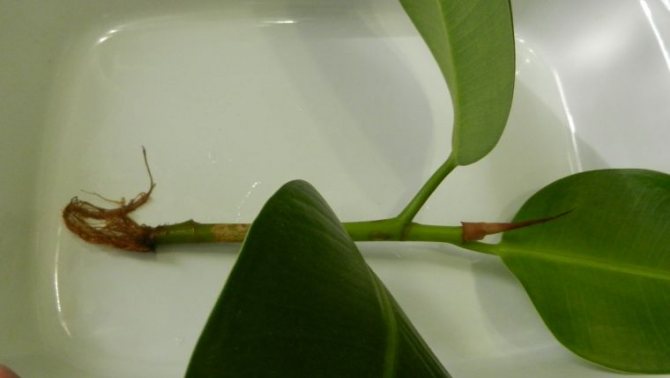

Cuttings can also be rooted using wet sand. Cut cuttings are washed from the sap that has emerged, dried and planted in pots with wet sand.
For better and faster rooting, the seedlings can be covered with a transparent jar to obtain a greenhouse effect.
Correct and rapid reproduction of Benjamin's ficus - video tutorial:
How to form and grow ficus trunks
To give the stem of the plant the necessary shape, several specimens of ficus are planted in a flower pot.They should be equivalent semi-lignified shoots, the length of which is 15 cm or more.
To create a braid trunk, three plant shoots are planted in advance. To form a trunk in the form of a spiral, two shoots are enough, which, as they grow, intertwine in accordance with the intended curl.
Weaving the trunks into a braid or spiral should be accompanied by the complete removal of side shoots. Crossing should be carried out not too tightly and firmly, so as not to disturb the thickening and development of the trunks.
An equally interesting solution is weaving from six or eight young trunks. But for this method, the trunks are planted at a distance from each other, and a cardboard tube is inserted into the center between them, after which the adjacent trunks alternately intersect.
Growing problems
Among indoor plants, the Benjamin plant has an average degree of difficulty in growing, so you need to pay attention to its whims.
Most often, novice florists have such problems when growing Benjamin's ficus:
- Dry leaf tips in winter, it signals about insufficient air humidity, which is most often associated with the inclusion of heating. In this case, it is required to increase the frequency of spraying, organize artificial lighting to increase daylight hours. This will help the plant to wait for spring calmly and without loss.
- The plant sheds leaves, the so-called sudden leaf fall should alert the owner of the ficus. Thus, the flower reacts to abrupt changes in the conditions of detention, for example, a decrease in temperature, the appearance of drafts, a change of place. Also, such a reaction can occur with abundant watering in winter, when it would be worthwhile to reduce the amount of moisture, but this did not happen.
- The change of seasons in any deciduous plant causes yellowing and shedding of leaves... Ficus in this case is no exception. However, if this happens at a different time not associated with the natural onset of autumn, it is necessary to sound the alarm - there are mistakes in leaving. There are two main reasons due to which the leaves of the ficus fall: an excess of water, which can destroy the plant, and too low a temperature.
- If the plant stands still for a long time, does not grow or develop, it is worth assessing whether the size of the pot is correct. The roots begin to wither, stop developing and die if the pot is too large in relation to the size of the plant, on the contrary, too tight a container prevents the development and formation of the crown.

Ficus sheds leaves for a reason
If correcting mistakes in the care and maintenance of a flower does not lead to improvements and the desired result, you should pay attention to the presence of diseases and pests.
How to pinch so that it is bushy and lush?
For overly tall plants, the procedure for the formation of new lateral shoots remains relevant. The ficus owner can use several ways:
- Japanese method. Suitable for small flowers that do not fit on a windowsill.
- Pruning. If you remove the top of the plant, then the ficus will give new shoots. This will make the flower more lush. But it should be borne in mind that if the procedure is performed incorrectly, the ficus will continue to grow up.
Important! When using the Japanese pinching method, branches can be tied not only to the trunk, but also to pegs specially driven into the ground.
Diseases and pests
Among the diseases that affect Benjamin's ficus, the following are noted:
- Anthracnose - with this disease, the appearance of dark brown spots, developing into ulcers, is noted. If untreated, the plant dies. To combat, use fungicide treatment, removal of affected leaves, reduction of watering and spraying, daily airing.
- Tserkoporosis - small black dots appear on the back of the sheet. The treatment is used as with anthracnose.
- Dropsy - cork growths appear on the back of the leaf, arising from overflow. The affected leaves are removed, and the plant is given proper care.
Ficus Benjamin is susceptible to attack by various pests, most often it is spider mites, aphids and thrips.

The most dangerous among them is the spider mite, it quickly damages the plant and adapts to various chemicals, so it is worth starting a fight with it at the first signs of the disease.
To kill the tick, you can use folk methods, for example, garlic tincture, processing the foliage with laundry soap, or you can use an insecticide.
Ficus is an amazing plant, a lot of folk signs are associated with it. It is believed that a flower helps a young woman to know the joy of motherhood, and brings happiness and harmony to the house.
However, in addition to mystical properties, the flower also has bactericidal properties - in a room with ficus, the number of bacteria in the air is reduced by 40%.

Ficus Benjamina Nastya
Thus, despite all the difficulties and difficulties in caring for a flower, you will be rewarded with the beauty and useful properties of the plant.

Ficus "Benjamin" is distinguished not only by its unpretentiousness and many useful properties, but also by the fact that it can be easily propagated.
At the same time, it is difficult to grow it from seeds.
Rejuvenating procedure
The rejuvenating type of pruning is carried out to restore the decorative effect of old plants, the shoots of which have lost their vitality.
If, in the event of a strong, prolonged drying out of the soil, the branches of the trees dry up, there is no need to rush to throw away the ficus. Anti-aging pruning should be done.
The procedure for pruning rubber ficus is carried out before the beginning of the growing season in spring. In this case, all dead branches are cut, shortening the living ones by half. Cut off not only the main shoots, but also the second-order shoots. All sections are sprinkled with activated carbon.
Ficus Benjamena
Growing ficus
How to grow ficus "Benjamin" at home? It is best to do this in spring or summer, when plants are actively growing.
During this period, shoots take root well and young ficuses grow strong and healthy.
From a twig
How to grow ficus "Benjamin" from a twig? For propagation, take branches from the top of the plant or side shoots.
The branch should be covered with young bark, but not yet have time to woody. Length - 12-15 cm. There should be at least three buds on a cut branch.
Read about ficus diseases and pests, as well as methods of dealing with them, here.
Cut the twig obliquely with a very sharp knife. Beforehand, be sure to sharpen the point with a bar and polish with a soft cloth or use an office knife with replaceable blades. The smoother the cut, the better the branch will take root.
Tear off the bottom leaves. Leave only 2-3 leaves at the top.
Rinse the branches with cold water immediately after cutting.
If not washed off, it will turn into a kind of rubber and tightly clog the pores of the twig, preventing it from absorbing water.
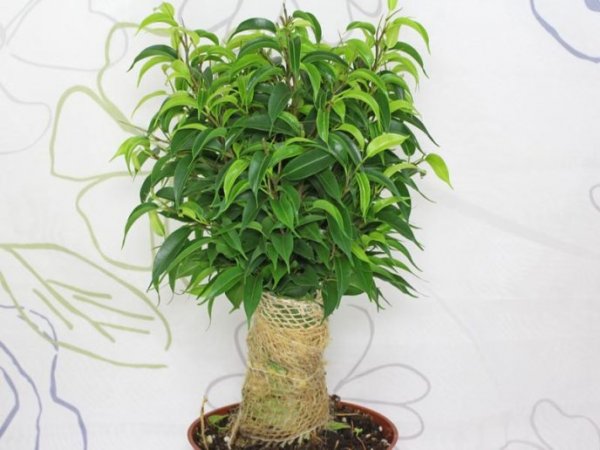

Dry the washed twig in the air for a few minutes, and then place it in a container with warm water.
You can dissolve a little root stimulant in it.
The water should be boiled, and the vessel should be darkened.
It is best to use a brown plastic bottle that you cut in half - you will put a twig in the bottom and cover the top so that the water does not evaporate too quickly.
You can also use any other vessel, covered with a film on top, but then you will have to take care of darkening - direct sunlight will burn the twig in a few hours.
A mini-greenhouse is necessary for the cuttings, because the leaves can dry out in the air. Leaves should not touch the water, otherwise they will rot.
You can immediately plant them in moist soil - a mixture of peat, perlite, vermiculite and sand in equal parts and cover with a greenhouse.
This will help avoid a difficult and dangerous transplant procedure, but the roots will develop more slowly.
Place a greenhouse with twigs in a warm and bright place for 2-3 weeks... Every day the greenhouse needs to be ventilated. 15 minutes each.
Remove dead leaves and cuttings regularly and add water as needed. The first sign that everything is going right is the appearance of growths in the lower part of the twig. After that roots will develop from them.
When the roots reach length 1-2 cm, it's time to transplant the plant. Be careful, the roots are very fragile, they are easy to break.
The twigs need to be planted in a special lightweight substrate. Often for this, a soil mixture is used, consisting of sand, peat, perlite and vermiculite in equal parts.
And if it's too late, then from a lack of oxygen at the roots.
The soil of young ficuses should be moist, but without stagnant water. The plant still needs a greenhouse, do not remove it right away, but the ficus must now be frequently ventilated - an hour and a half a day.
After a week or two, if rooting is going well, the greenhouse can be removed.
Do not add fertilizer to the soil. Now the ficus needs only air and water.
When young leaves reach normal size, rooting can be considered complete.
From the cutting
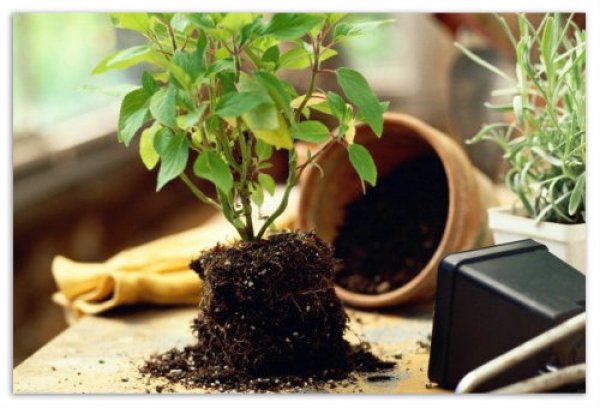

How to grow ficus "Benjamin" from a cuttings?
This process is not much different from rooting a twig, except that it allows you to get many plants at once.
Slice cuttings from the main trunk. It is enough to take a segment with one intact leaflet.
The upper cut must be made a centimeter above the bud, which is in the leaf axil. This cut should be straight.
Make the lower, oblique cut every ten centimeters.
All the recommendations for choosing a knife given in the previous part of the article apply to this case too.
To prevent the young roots from having to punch through the thick bark on their own, make vertical cuts in the lower part of the root, three centimeters long, being careful not to damage the wood.
Then root the stalk using the same method as the twig. The only difference is that it is better to grow the stalk immediately in the ground, and not in water. This will help you avoid transplanting, which young ficuses do not tolerate well.
In conclusion, it should be said that it is not difficult to grow ficuses from a cuttings or twigs.
The main thing is to follow all the instructions and the plant will be strong and healthy.
The photo shows the result of correct cultivation of ficus "Benjamin" at home:
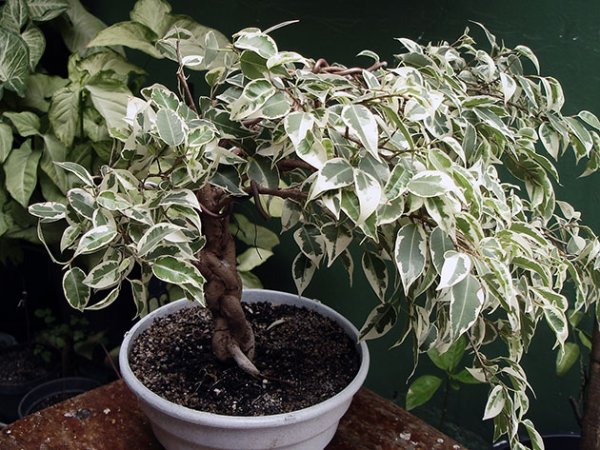

What if it really stretches up?
When the flower reaches up, it sheds the lower leaves in the process. Most buds form at the top of the plant. Therefore, you should not allow too much growth upward.
If the ficus needs to be made more voluminous and small, then they resort to pruning the plant. But it is important to remember that the cut should only go obliquely and is located above the kidney. In addition, gardeners use the following methods:
- They lower the extra branches down and tie them to the trunk or pegs. This allows the buds on top to sprout strong shoots. The procedure is carried out several times in order for a sufficient number of lateral shoots to grow.
- Sometimes kerbovka allows you to achieve the appearance of new shoots. To do this, a small incision is made above the sleeping kidney, about a third of the depth. The bark in this place must be removed in order to weaken the root nutrition.
- In special cases, gardeners use a special stimulation of the flower with plant hormones - cytokinins. With their help, the lateral axillary buds begin to dominate, and not the apical ones.
Important! Any cuts are made with a disinfected knife, otherwise you can provoke the appearance of a fungus or infection.
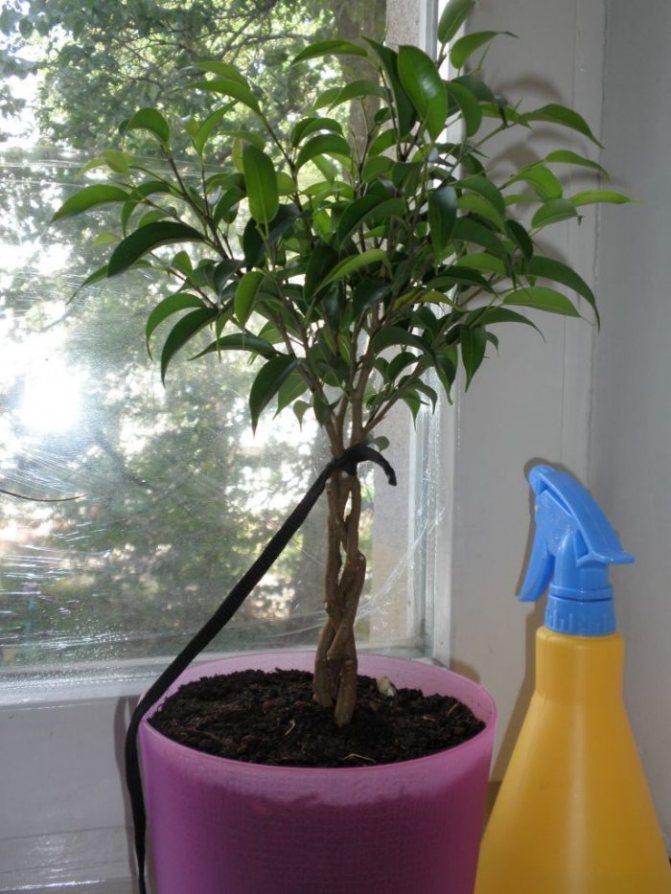

Any ficus owner knows that the plant requires careful maintenance. Otherwise, you may be faced with the fact that the top of the flower rests against the ceiling. Therefore, the annual pinching held in the spring is a must.And you should start forming a crown of the desired height and volume as early as possible, while the ficus is still young.
4.5 / 5 ( 2 votes)
Useful video
The video shows recommendations for growing Benjamin ficus at home:
If you find an error, please select a piece of text and press Ctrl + Enter.
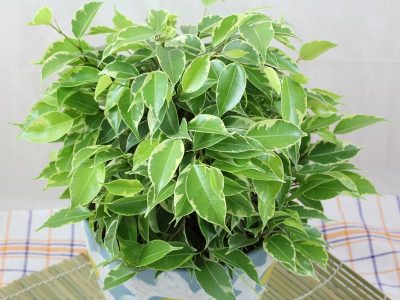

Growing Benjamin's ficus is not easy. This plant is native to tropical countries, so it loves humid air, bright lighting and warmth.
Despite the exacting conditions of detention, the ficus Benjamina (Ficus Benjamina) is very popular because of its beauty.
It grows up to one and a half meters in height, forming a lush tree, the trunk and branches of which are completely covered with small white-green leaves. Especially a lot of white spots in the variety Starlight
... In shape, the leaves of the ficus are similar to cherry leaves, only without cloves at the edges.
Ficus longline bole
A tiered stem is a tree shape with a split crown. A trunk without branches remains between the tiers. Such a tree can have from two tiers.
The tiers are built up gradually. At the first stage, a simple standard tree with an oval or round crown is formed.
Then pruning is carried out so that the central, upward shoot grows. From it, you can gradually form an extension of the trunk and a new tier of the crown. This process of crown formation is the longest.
Faster, you can plant two cuttings and wire their trunks. Gradually, they will merge into one trunk. Only the top will remain disconnected.
If you plant cuttings with different colors, you get a very beautiful tree with multi-colored tiers. Is it possible to grow a longline stem from one cutting by cutting a ficus? To do this, it must grow upward, forming a tall, elongated single stem. Having formed the lower part of the trunk, the crown is divided into three parts: the upper and lower parts will be tiers, and the central part will be the bare trunk. The side shoots in the center are removed, and the tops of the trees are pinched.
Benjamin Ficus Care
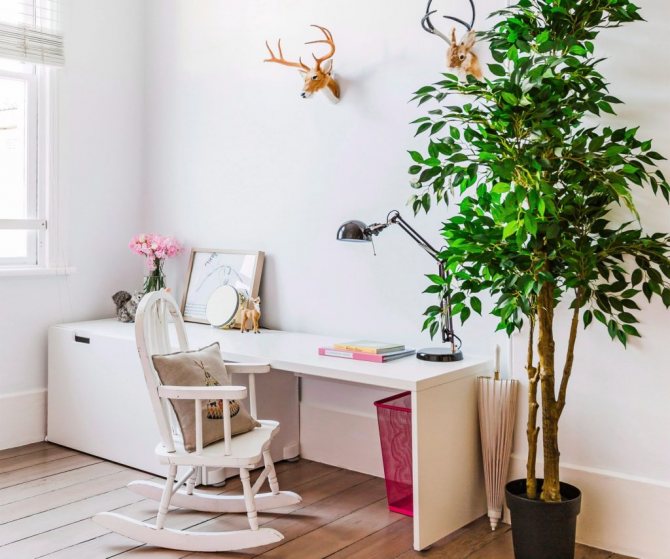

Ficus Benjamin feels good in bright, but diffused light. Direct sunlight leaves burns on the leaves, making them faded, the plant loses its decorative effect. In summer, the temperature should not rise above + 25 ° C. In extreme heat, the tree sheds its leaves, as in a lack of light. In winter, it is enough to keep the room temperature +17 ° C.
Benjamin's ficuses love frequent spraying. Moisture protects leaves from spider mites, washes away dust, prevents leaf fall, indicating inappropriate conditions.
Plants are watered regularly, more often in summer than in winter. If water has accumulated in the pan, it must be drained immediately - the roots of benjamin ficus do not tolerate dampness. If the soil dries out, the plant will immediately get rid of some of the leaves to reduce evaporation. Therefore, when choosing an irrigation regime, you should adhere to the rule - take up the watering can when the top layer of the earth dries up, but moisture will still remain in the depths.
Top dressing is carried out every 2 weeks, in winter, once a month. Fertilizers are suitable:
- Agricola for ficuses;
- Bona forte for ficuses and palms;
- "Flower paradise" for yucca and dracaena ficuses.
If the plant begins to shed its leaves, you need to move it closer to the window, or vice versa - remove it from the draft. Check the room temperature and soil moisture in the pot. If the soil is dry, the ficus must be watered first with clean water, and then with fertilizer diluted in water. After a while, the tree will restore its decorative effect.
Who is this plant suitable for?


Room
ficuses reach a significant size, so they are suitable for owners of spacious rooms. The plant is used for landscaping light offices, shopping centers, lobbies. An adult bush can be kept in the back of the room, a few meters from the window.
There are signs associated with this type of ficus. Esotericists note its beneficial effect on the psychological environment in the family.Ficus is a real symbol of home comfort. It improves the energy of the home, increases the comfort of everyone in the room. In its homeland, it is considered a sacred plant that brings good luck and happiness.
Ficus Benjamin is a beautiful, popular, but requires care and regular maintenance plant. It perfectly decorates the interior, suitable for apartments and public spaces.
What shape can the ficus be given?
First of all, decide how to cut the ficus, what shape to give it. The sequence of actions during the procedure will largely depend on this. The simplest forms are:
- Stam... After creating such a shape, the ficus will look like a ball on a long handle. To do this, you will have to bare all the lower shoots and form a round crown. If there are several powerful shoots below the plant, then they are intertwined with each other, forming a semblance of a single trunk.
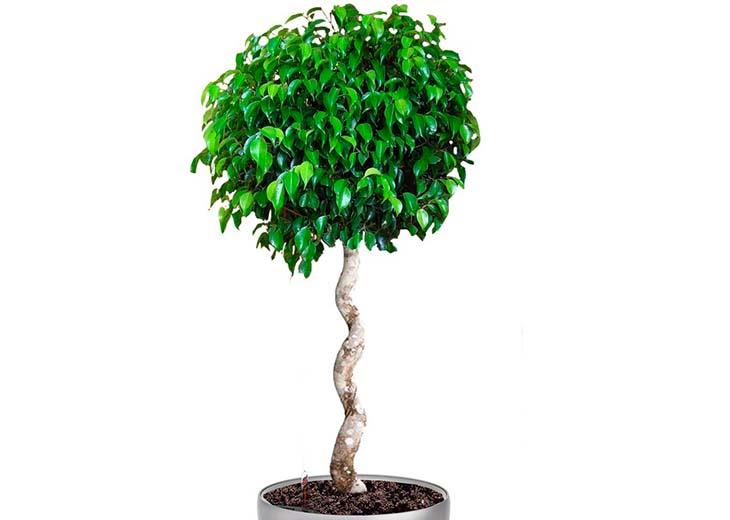

- Arc... To create such a figure, you will need to install a wire frame on which the shoots are laid. They should be tied neatly in several places.
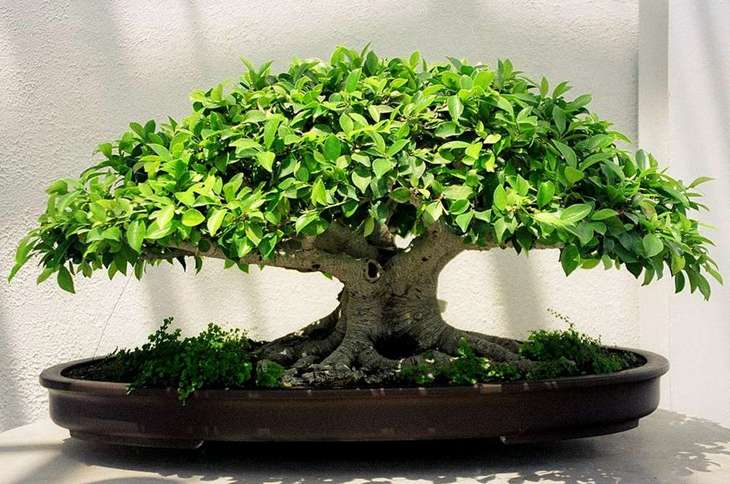

- Bush... Ficus can be given the appearance of a real bush. It will become a laconic addition to a country-style interior.
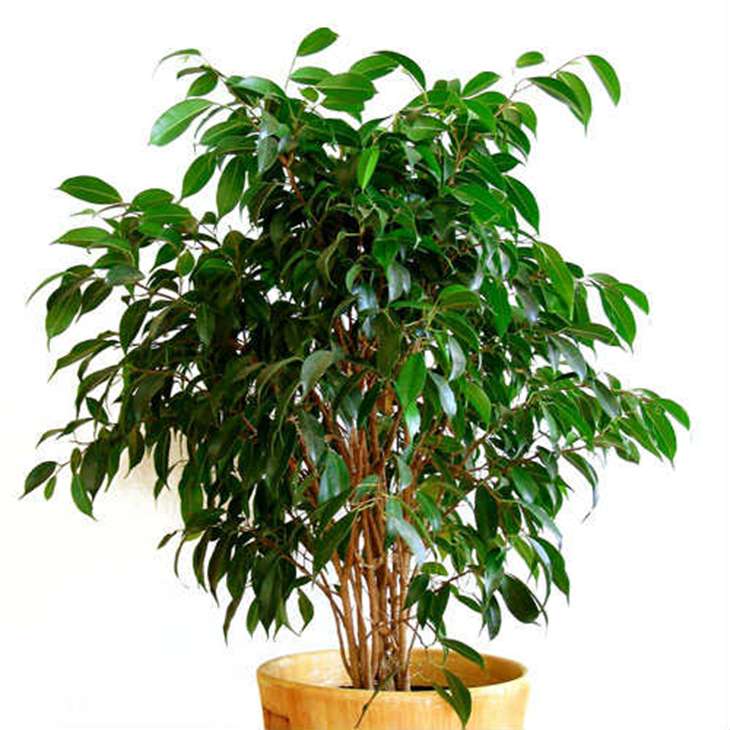

- Pyramid... With proper pruning, ficus is easy to give a pyramidal shape.
- Bonsai.
The tree can be given other unusual shapes. It all depends on your imagination and compliance with the rules of pruning.
Video: braiding ficus with a pigtail
Ficus rusty and rooting
Further, your attention is presented to a photo and description of such types of ficus as rusty and rooting.
Ficus rusty (Ficus rubiginosa L.). Mulberry family. Homeland - Australia. Indoor evergreen, quite common among amateurs. Ficus rusty in appearance is very similar to elastic ficus, but it grows more slowly, it has smaller leaves, and it is more hardy in indoor conditions. The leaves of the rusty ficus are elliptical, obtuse, 12 cm long, smooth above, dark green, underneath covered with tomentose brown pubescence. In winter, it feels great at a temperature of 6-8 ° C. Cuttings of ficus rusty rooted poorly, but it reproduces well by layering. Care and maintenance are about the same as for elastic ficus. Ficus rusty is used to decorate warm, bright small rooms.
Rooting ficus (Ficus radicans Desf.). Mulberry family. Homeland - India. A climbing plant with thin graceful stems and medium-sized oval-elongated dark green leaves 5-7 cm long. The stems can twine around a support or hang down if grown as an ampel plant. It is unpretentious, undemanding to lighting, heat and the composition of the land mixture, but it grows better on a mixture of sod, leaf, peat soil and sand (2: 1: 1: 1). Propagated in spring by green cuttings, which are planted in wet sand under a glass shelter. Can root in a water bottle. After rooting, the cuttings are planted in small pots. Care consists in abundant watering in spring and summer and careful in winter. On hot days, spraying the entire plant 2 times daily is helpful. During growth, it is necessary to give liquid top dressing, recommended for elastic ficus. In the first 3 years, the rooting ficus is transplanted annually in early spring. Old plants are transplanted less often, after 2-3 years.
They are used for wall decoration near windows in various suspensions, sometimes in combination with other climbing plants, in rooms and public areas with sufficient air humidity, light and warm. It can grow on nutrient solutions in hydroculture or in an ion-exchange substrate.
How to form a ficus crown
But with the help of skillful shaping and competent pruning, you can give a green pet a very different shape (arched, standard and even bonsai). Such a plant will become an exquisite home decoration.
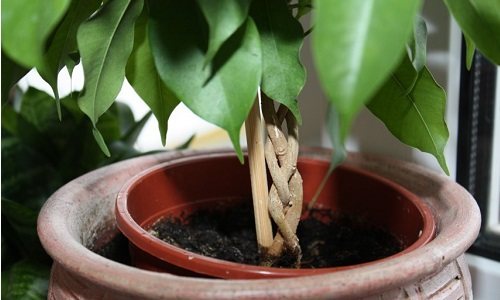

Weaving ficus trunks takes a lot of time and patience.
But that's not all: skillful flower growers have created such a type of creativity as weaving ficuses. This is a more complex form of intervention in the development of the crown of a plant, requiring not only patience, but also the presence of regular free time.
Specialist recommendations
Creating unusual designs, sooner or later the trunks and shoots of individual ficuses will have to be fixed. Materials such as twine, cling film, wire or thread are suitable for this purpose. To accelerate the accretion of individual parts, you can first cut off pieces of bark from them, then wipe off the juice and connect with a fixer. It is recommended to change the material used once a month to prevent thread or wire from growing into the bark. In addition, it is important to remember that strong tightening is harmful to the ficus.
Ficus Benjamin is an ornamental houseplant. It has earned the love of flower growers due to its lush crown with bright green foliage. Benjamin decorates rooms, purifies and disinfects the air. Unlike many indoor plants, this type of ficus feels great in the same pot with its fellows. This property is used by gardeners to give the flower even more splendor and decorative weaving. With its help, the trunk is given an unusual shape.
Forms of creeping ficus and its reproduction (with photo)
Creeping ficus, or small ficus (Ficus pumila L. (F. repens hort., Non Willd.) Graceful ampelous plant. Stems are covered with small (2-2.5 cm) heart-oval leaves of bright green color. On the underside of the stems there are roots - suckers, which the ficus is attached to any support. The shoots hanging from the pot with the slightest lack of water easily lose their leaves. Therefore, in the pot in which the creeping ficus grows, it is necessary to put vertically a piece of cork, board or branch of a tree. With constant spraying, they will soon become well covered with leafy shoots ficus, which are attached to them with sucker roots.
It is used for vertical gardening, as ampelous, it grows easily and occupies the entire free area.
There are several forms:
F. pumila var. minima - leaves are small, up to 1–1.25 cm long.
F. pumila var. macrophylla - large leaves.
Variegata - leaves with a white border.
Sunny - the border is not continuous, but in the form of separate spots.
White Sunny - with a wide creamy border.
This type provides unlimited opportunities for the manifestation of the creative imagination of the owners.
Pay attention to the photo - creeping ficus can be used as a ground cover or ampel plant:
They are used to decorate vertical surfaces, however, it is necessary to remember about the increased demands of this type of air humidity. In a pot with a plant, you can insert a figured piece of a board, an original shape of a branch, wrap them with moss and fix them. Ficus easily "overgrows" these supports, forming original green shapes. It is only necessary to constantly spray the plant and moisten the support, since with the slightest lack of moisture, the plant easily sheds its leaves.
Found in tropical rainforests, on rocks in China, Japan, and the Malay Archipelago.
Reproduction of creeping ficus is carried out in the spring by cuttings. Cuttings root only under glass in the warmth with abundant spraying. After rooting, they are transplanted into small pots in a mixture of turf, leaf, humus earth and sand (1: 1: 1: 1/2). Young plants are carefully and gradually accustomed to dry room air.
In winter, creeping ficus should be kept in cool rooms.
Basic rules for pruning
Ficus Benjamin should be pruned in the first months of spring. Usually, this is the end of March or the beginning of April. It is best to form a crown when shoots begin to grow on the tree.If the buds have already appeared, the most favorable time has come for pruning procedures that will not harm the culture, but will only benefit it. Since all the plants have not yet had time to enter the phase of active development and growth, after such a painful event, there will be time for the wounds on the ficus to “heal up” and it comes to its senses.
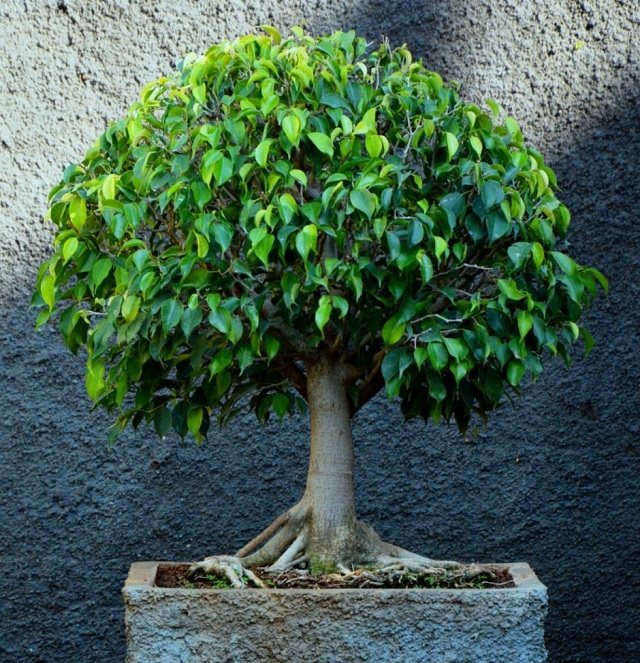

As tools and tools you will need:
- sharp pruning shears (blunt cutting objects cannot be used, as they will crush the branches, and then they will grow poorly);
- activated carbon or wood;
- napkins;
- a suitable disinfectant solution (alcohol or manganese).
In order to properly form the crown, it is important to know that trees have different types of buds, which have different effects on the process of their growth. When cutting the side stems, the top becomes lush and spreading, and if, on the contrary, the top is pinned or cut off, the shoots will begin to develop from the side, and the tree will begin to grow rapidly in breadth.
Before starting the event, it is imperative to disinfect the pruner so that the tree does not get sick due to the ingestion of harmful fungi spores. If the branches are thick, they are cut close to the bud, with the pruner tilted at an angle. The shortening is carried out by one third, after which you should take a dry napkin and remove the milky juice, which always flows out of the cut. Finally, the "wounds" are treated with finely crushed activated carbon or wood ash. When pruning thin branches, you can do without disinfection of the cuts, however, it is recommended to remove the juice, so as not to leave whitish spots on the tree trunk.
Ficus formation and pruning
Then spray the plant with Actellik solution (1-2 ml per liter of water) or water and spray with Actara solution.
Spider mite: first, small discolored spots appear on the leaves, if you look at the lumen of the leaf, you can see punctures. Gradually, the leaves turn yellow and dry out. With severe damage in internodes and on the back of the leaves, a cobweb is visible.
Control measures. You can use drugs such as Fitoverm, Aktofit, Agravertin, Akarin - at the rate of 10 ml per 1 liter of water, or Vertimek (1 ml per 1 liter of water). The treatment must be repeated after 3-5 days - if the weather is hot or warm (26-24 degrees) and after 7 days, if the air temperature is 20 degrees and below, since these preparations do not kill tick eggs.
Thrips - high temperature and low air humidity contribute to the appearance. On the underside of the leaf, thrips lays numerous colonies, and light dots appear on the upper side of the leaf. As a result, the upper side of the leaf becomes grayish brown with a silvery sheen.
Control measures. The plant should be sprayed, if necessary, repeatedly with insecticides (fitoverm, decis, actellik, inta-vir).
Read more about pests of indoor plants in the section "pests"
Types of ficus weaving
We need small Benjamin ficus seedlings of the same height. Their thickness should vary from 1 to 1.5 centimeters.
- Young specimens need to be planted in one container next to each other. Such actions will allow us to braid the pigtail neatly and beautifully in the future.
- First of all, we remove all the small branches on the sides on the stems, only the tops remain.
- Before the weaving process, be sure to water the plant well. With a sufficiently moist soil, the stems will be as flexible as possible. A certain time interval must be maintained between watering and weaving. Watering in the evening - weaving in the morning.
- Surely everyone has an idea of how to properly weave a pigtail. With ficus, things are a little different. We will have to weave the pigtail in parts as the stems grow. Do not forget to tie the braided part of the plant.
- At your sole discretion, you can adjust the strength of the weaving.If the stems are weaved a little weaker, then gaps will appear between them, which will look very decorative on adult ficuses. To make the holes the same, experts recommend inserting the same pencils between them.
Do you want all the stems to grow together into one? In this case, you need to carefully remove the bark in small parts from the trees at the place of their joints. Approximately half a year later, the trunks should grow together.
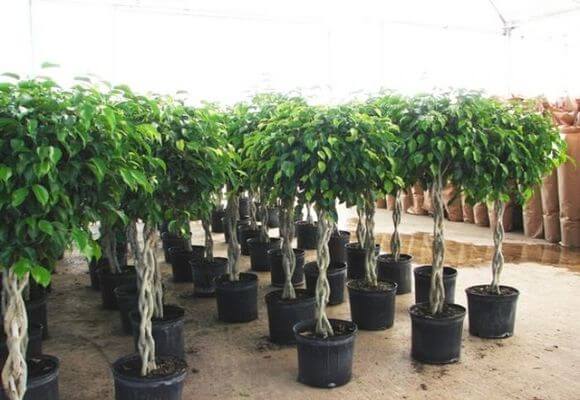

Types and schemes
There are several types of weaving:
- spiral (single or double) - the formation of the trunks goes in a circle, without crossing;
- lattice - plants planted in a row are intertwined;
- pigtail - resembles a popular female hairstyle;
- hedge - the trunks of the plants planted in a circle are intertwined, as in a lattice. There is free space in the middle.
Any of the proposed weaving patterns will allow you to give the trunk an intricate, decorative shape.
Spiral
The most popular type of weaving. To form a single spiral, only one shoot is needed:
- The plant is planted in a pot.
- Next to it, a round, low support is installed (a chock, a piece of PVC pipe, a dried bamboo stalk, etc.). The diameter depends on how wide the spiral turns should be as a result.
- When Benjamin reaches a length of 13-15 cm, his stem begins to wind on a support. So that equal distances are obtained between the turns, use inserts (sticks, pieces of rubber of the same length). As the flower grows, they are removed from the lower, already formed areas, and rearranged closer to the crown. The inserts cannot be left on for a long time, they will cut into the stem.
- When the required spiral height is reached, the support is removed.
A single spiral itself looks decorative. But if you use several seedlings, it will look intricate and unusual. The best option is twisting two or three trunks in parallel... Some growers manage to braid four, but it takes skill and effort.
Lattice
Quite a complex pattern for weaving ficus. To create a lattice, you will need an even number of seedlings and a voluminous pot, preferably not round, but square or oval. Sequencing:
- Small ficuses are planted in a row.
- When their growth reaches 10-13 cm, a lattice is formed. Adjacent trunks are crossed in pairs and secured in the desired position with twine or wide wire.
- The retainers are periodically loosened to avoid scarring.
- At the junctions, you can cut off the bark so that the trunks grow together.
The lattice can be made with an arbitrary cell size. If you want to achieve maximum symmetry, when tying, use a blank in the form of a piece of a wide pipe or a rhombus made of cardboard.
Hedge
The circuit looks like a spiral and a lattice at the same time. The columns are bent in a circle and intertwined:
- An even number of plants are planted in a pot (at least four, maximum - depends on the size of the container).
- A support is inserted between the young trees, as when weaving in a spiral.
- Then the plants are bent in a circle, but not parallel, but in pairs, towards each other. The direction given at the beginning is maintained as the stems grow. Therefore, there is a place of intersections with gaps-cells between them.
When the stems have reached the desired length, the pipe is carefully removed.
Pigtail
You can braid several plants at a distance of 3-15 cm from each other (depending on how voluminous the shape should be). If there is only one tree available, you can wait until it releases three or four identical side shoots.
They begin to give the stems the desired shape when they reach 13-15 cm:
- If the trees are close-planted, or there is only one plant, change the direction of growth of the extreme parts of the future pigtail from the central in opposite directions, tying them to a branch.If there are several of them, and they are planted at a sufficient distance, this step is skipped.
- Flip the right shoot over the middle at a 45-degree angle.
- Secure the trunks in this position with a woolen thread.
- Wait for the plants to stretch out a little.
- Cross the resulting center with the left seedling / shoot.
- As the plants grow, the steps are repeated until the stems are of the desired length.
Make sure that the size of the loops is the same. Free spaces can be left between the stems or they can be spliced together at the point of interlacing into one piece. It depends on what shape you want to get in the end.
Lattice
In addition to the method described above, Benjamin's ficuses can be intertwined in a different way - and with an equally remarkable result. This will require a larger number of seedlings - of the order of eight pieces (regarding how many of them exactly should be, it should be noted that any other close number is allowed - provided that it is even). For the rest, the list of points that must be taken into account when forming such a lattice looks like this:
- All barrels next to each other are crossed using a cardboard tube installed in the middle.
- In order for the created lattice to be formed extremely clearly, all young Benjamin ficuses must be planted in a line, while maintaining a specific distance between them.
- As soon as the stems reach the required height, they must be directed in the direction of interest to the owner of the plants. To solve this problem, you can use polyethylene or wrapped wire.
- The fasteners used must be loosened from time to time - in order to avoid mechanical damage to the ficus.
Also, for those who want to know how to braid Benjamin's ficus using the lattice method, it makes sense to take into account another important point. It involves the use of a coconut trunk, through which you can achieve the utmost originality of the design being created. Around it, at a distance of several centimeters, it is necessary to plant at least three Benjamin ficus, the side shoots of which are cut off.
Due to the fact that the humidity of the installed column is consistently high, the growth of air layers will noticeably accelerate, and this, over time, will lead to their interlacing and splicing with each other. This solution is very popular among exotic lovers, and we have to admit that this is completely natural and logical.
Basic weaving rules
Before proceeding with the description of the most popular techniques that allow you to braid the ficus in question at home, you should pay attention to the key points that need to be taken into account to solve this problem. If you make a list of them, then it will look like this:
- For the formation of a trunk, which has a very unusual shape, it is recommended to use three young Benjamin ficus. It is also worth adding that they should be approximately the same in height - up to 15 centimeters.
- You should choose plants whose trunks are no more than half woody. Taking this circumstance into account will help to braid them in the desired way, and therefore it is strongly not recommended to ignore it.
- If the owner of Benjamin's ficuses wants to weave them into a spiral, a pair of such plants will be enough for him, although even in this situation, the use of three trunks will look much more impressive.
- If a weaving option is chosen that involves working with three processes, then it is necessary to start its implementation when they reach a height of 13 centimeters.
- Each subsequent turn is performed as the ficus grows to a sufficient height. At first, for the implementation of this process, a soft woolen thread will be needed, through which the intertwined trunks are tied.
- The thread should be rewound with a frequency equal to two months, adhering to a dressing angle of 45 degrees.
Trunk formation
First you need to decide what style the bonsai will be. Then draw a rough outline of the tree and stick to it for the entire growing period. If the tree changes during the growth process, correct the scheme.
After landing, there is a lot of work to create the shape. Working with the barrel is considered one of the most painstaking and laborious. Even a tiny bonsai should have a trunk, the thickness of which in the lower third (at the base) is at least 1/6 of the height. It will take more than one year to create a thick bonsai trunk. Several techniques are known. If you follow them exactly, the tree will not grow in height, and the trunk will grow gradually. Let's take a closer look at the most famous of them.
1.
Methods and schemes for weaving ficus Benjamin at home
Ficus Benjamina has long taken a solid place in the ranking of popular houseplants due to its decorative value. This flower is often found in offices, as green ficus leaves dilute the cold atmosphere all year round. In addition, the flexibility of the trunks allows the stems to be braided into bizarre shapes. Benjamin ficus weaving is considered a kind of art by experienced florists.
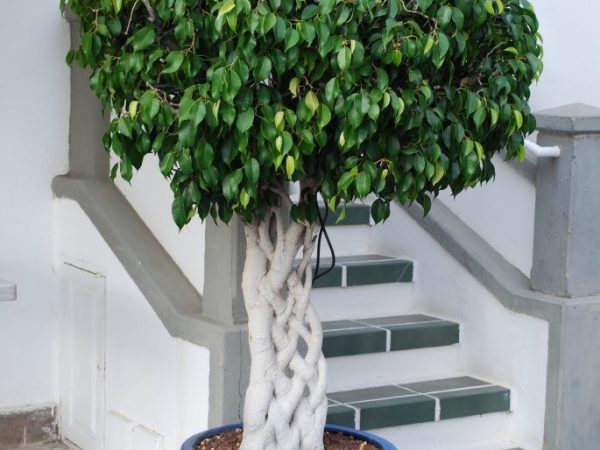

How to braid Benjamin ficus at home
However, a certain skill is required for a beautiful result. Many novice florists are wondering how to weave Benjamin's ficus at home? To begin with, you need to bring the flower into the proper form for weaving.
Ficus Benjamin as a house plant
Ficus Benjamin is a home decorative culture from the lianas family, it is quite popular in the modern world.
This flower requires the right conditions, and sometimes caring for it can seem difficult. However, a big plus of this bush is that, subject to all maintenance standards, the flower looks extremely fresh all year round, thanks to its bright green leaves.
That is why ficuses are often used as a decorative flower in large companies and firms. The intertwined types of ficus are considered art at all. However, in order to properly weave Benjamin's young ficus, you need to adhere to the rules of content.
Rules for keeping ficus at home
Before intertwining the Benjamin ficus shoots, you need to make sure that the flower is comfortable in the house. To do this, you need to check the foliage and trunk of the crop, and also adhere to the maintenance rules. Ficus weaving is possible only when the flower is healthy. Of the most basic recommendations, the following can be distinguished:
- First of all, after buying a plant, you need to pay attention to the foliage of the flower. Many breeders rub the leaves with various agents for richer colors. On the first day after purchase, you should wipe the crown of the plant with a damp cloth.
- Ficus loves constancy, so you need to immediately determine the location of the flower. It is impossible to rearrange the plant without urgent need, this may deteriorate the appearance of the flower, it is even capable of getting sick.
- This plant cannot grow without good lighting. The best location for ficus will be a wide window sill facing the east side. Ficus is a fairly water-loving flower, so bright sunlight can dry out the crown and trunk. In winter, the plant needs additional lighting.
- Ficus is very sensitive to frequent rains and drafts, so the flower should not be kept on an open balcony.
- The temperature of the content should not exceed 15 ° C, while it is important to avoid temperature fluctuations.
- In the room where the flower grows, the air should not be too dry. If the humidity in the room is too low, then spray the plant with water.
- Once a month, the ficus needs water procedures - it is washed with warm water.Before returning the flower to its place, it should be thoroughly dried.
The weaving depends on the growth of the flower. If any of the plant maintenance rules are violated, Benjamin's ficus will not braid.
Benjamin ficus weaving rules
Many inexperienced florists are wondering how to braid Benjamin's ficus at home. The intertwined trunks of decorative flowers are no longer exotic in our world, and even a beginner is capable of braiding a ficus.
There are different options for how a flower should be intertwined. The preparation of the plant depends on the choice of a particular scheme. For this, 3 young ficuses of the same height are planted in a separate pot. In some cases, more can be deposited, but then you need to pick up a large container. Plants should have fresh stems. The appearance is given during the growth of the flower. For a spiral, 2 sprouts are enough, but with three weaving will look more interesting. If the choice fell on the "pigtail" shape, then each ficus shoot should be about 13 cm.
To prevent the plants from unraveling under the influence of gravity, they are held together with a soft wool thread to tie the trunks. It can be purchased at flower shops.
The thread should be rewound every 2 months, otherwise the stalks of the ficus can be seriously damaged. In some cases, the thread can even grow into the flower, which should not be allowed. When changing the harness, sometimes you can see the plant's milk on the stem. This is a common occurrence for this procedure, but care must be taken that the wounds on the stem of the flower are not deep.
The ligation of the trunks must be strictly at 45 °, otherwise the ficus may begin to grow crooked. To avoid this, in some cases, additional support is placed. It is best to use rattan or bamboo as a support. It should also be remembered that weaving a flower takes a fairly long amount of time. It can take over a year to create the desired shape.
Types of weaving ficus
The most common type of Benjamin ficus weaving is called a spiral. The reason for the popularity of this method of braiding Benjamin's ficus lies in its simplicity and a small number of sprouts. In most cases, a strong support is enough for the stems of the flower, around which the stems are woven.
The most important thing is to remove the side shoots and guide the plant in time. When the spiral from the stems reaches the desired height, the support can be removed from the pot, and the flower will delight with the intertwined trunk. In some cases, a spiral can be made from 4 shoots, but such a trunk will be more of a hassle.
Hedge
The next way to braid the stems of a flower is considered to be a hedge. For this, several seedlings are used, which are placed in a pot in one row. Sometimes such a fence is made in a circle. This method of growing plants is simple because you don't have to deal with the stem of the plant.
The hedge is mainly formed by crowns, and the beauty of this shape depends on how many sprouts fit in one pot. You should try to keep the distance between the shoots at least 10 cm, otherwise the roots of the flower will intertwine and some shoots may die.
Features of the
Weaving ficus Benjamin is easy to implement if you take young shoots, and then grow them yourself to a mature state. If you try to do something with mature bushes, then nothing will come of it. The reason is that it is possible to bend or twist the trunks only until they become stiff. In addition, the young stalks of the Exotic ficus are still devoid of bark, which means that they can be transformed in a spiral, braided into a braid, or directed in the direction opposite to their growth.
Ficus turns yellow
The first reason that can cause yellowing of the leaves is a violation of watering.
The leaves turn yellow if the plant has not been watered for a long time, while they fall off one at a time.In ficuses with large leaves, when dry, the lower leaves turn yellow, in small-leaved ones - in different parts of the crown.
With waterlogging, excessive watering, the leaves of the ficus also turn yellow, but the main difference is this: when dry, the leaves turn yellow slowly and fall off one by one, when overflowing they turn yellow faster and fall off in large quantities: in large-leaved plants, 2-4 pieces at a time, in small-leaved ones - 20 -30 leaves per day.
Do not rely on your own memory, but dig up the earth and touch it in the depths of the pot.
To avoid waterlogging of the soil: if water remains in the pan after watering, it must be drained. Water less often in winter than in spring and summer.
When transplanting in a pot, drain well. If there is no expanded clay, then they put a broken red brick - it collects excess water well. Add pieces of birch charcoal to the soil - they prevent rotting processes. And add a few tablespoons of vermiculite to the soil.
How to braid?
In principle, braiding any shape is not particularly difficult if you properly prepare the seedlings and use the schemes presented on the Internet.
Selection and preparation of seedlings
In order for the trunks of Benjamin's ficus to intertwine in the future, it is necessary initially to correctly select the seedlings for planting. Their height is 10 centimeters and corresponds to the maximum flexibility that a plant can have. In addition, it is at this stage that there is no crust, which negatively affects elasticity. To braid the simplest compositions, you will need at least 3 seedlings, although it is better to take more.
If a more complex scheme is planned, for example, a hedge, you will need an amount that can completely fill the diameter of the planting container.
It is important to maintain an equal diameter of the shoots, otherwise the overall picture will be spoiled. This is especially true in the case of braids or circular weaving. It is better to plant the stems in early spring - so their development will be quite fast, in a month and a half it will be possible to start creating a decorative composition. Separately, it is worth mentioning the splicing of the trunks - in this case, partially woody seedlings will be required, the length of which reaches 15 centimeters. While they are growing, the bark will have to be pruned regularly where they meet. This will have to be done very carefully so as not to harm the plant.
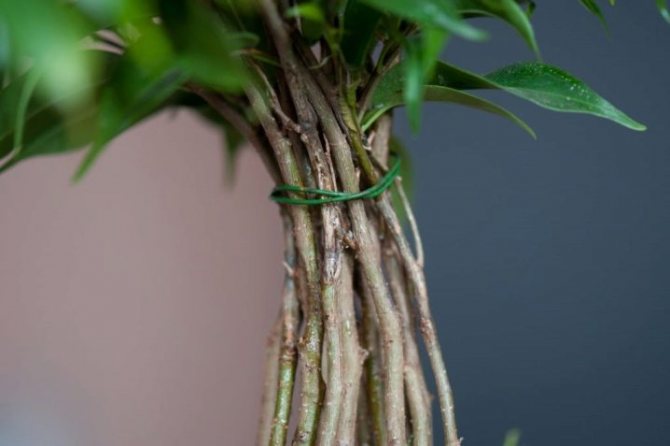

A pot or pots are selected even at the stage of thinking over the composition. A hedge will fit perfectly in a wide container with high sides in the shape of a rectangle or oval. An elegant and narrow pigtail or spiral will be enough for an ordinary pot. In addition, we must not forget about the number of shoots used - this also determines the size of the tub.
When planting ficus at the bottom of the pot, it is imperative to organize a drainage layer of brick chips, pebbles, expanded clay or ordinary rounded pebbles. The height of this layer is determined depending on the height of the container itself. Drainage will prevent waterlogging and improve soil aeration. If by that time the cuttings have formed too long roots, or some of them have already been damaged, then it is worth cutting them off. Part of the soil is laid on top of the drainage. It can either be purchased ready-made in the store, or you can create it yourself by combining peat, river sand and leafy soil.
The seedling is installed so that the root collar remains above the level of the ground surface. The roots are straightened and covered with earth. It is important to make sure that there is at least a couple of centimeters between the ground and the edge of the pot. The soil is slapped lightly and irrigated with warm water enriched with growth stimulants.
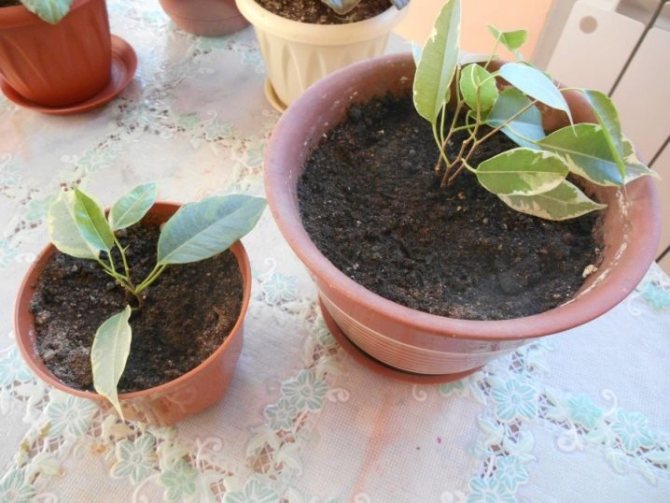

The first fertilization is allowed only a month after the seedlings have taken root.
Technology
It is better to start braiding the shoots when they reach 13 or 15 centimeters, but have time to finish everything until the trunks are covered with bark.To implement an idea with your own hands, it is enough to find schemes on the Internet, and then implement them step by step. For example, the formation of a normal pigtail comes from 3 or 6 seedlings. The weaving should not be tight - it is better to leave gaps, the sizes of which can be adjusted with pencils or sticks of the same diameter made of wood. Each new loop can be created every one and a half or two months.
It is better to fix the top slightly with a cloth ribbon or woolen thread. Again, excessive efforts should not be made, otherwise the nutrition of the ficus will be disrupted, and one of the shoots may even die. During the weaving of the trunks, the shoots on which the buds appear, looking inward, will have to be cut off. If necessary, the crown should also be shortened to achieve a more attractive shape. Experts recommend, while the shoots are still growing, to fix the upper layers on supports.
Before the immediate start of weaving, it would be good to water the ficus abundantly to give the stems additional flexibility. You can also carry out a more complex procedure - take the ficus to the bathroom, protect the soil with plastic wrap and provoke vaporization by turning on hot water. The pot should remain in this state until the flexibility of the plant increases.
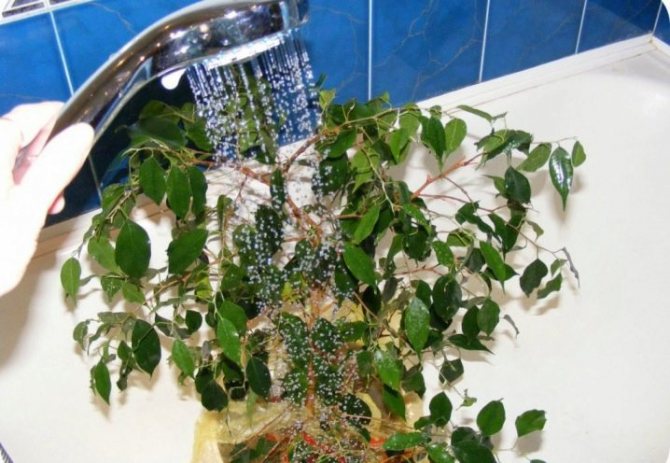

To create a spiral, it is enough to braid the growing shoot around a nearby support. The latter must be securely fixed, otherwise the development of the trunk will be disrupted. The double helix is formed according to the same principle, only the shoots are directed parallel to each other. A spliced variation of the double helix is made by cutting off a portion of the bark where both shoots meet. In all cases, the circular weaving is secured with a thread that cannot cut the plant.
It is important to ensure that the height of the strut matches the height of the trunk.
Shoots, which are to form a lattice, are planted in a line along the diameter of the installed tube, keeping an equal gap between them. Over time, they are directed in the desired direction using wire or cling film. If at some points the shoots are to be connected, then it is better to gently fix the place with a woolen thread or gauze cloth. If the side shoots begin to knock out of the composition, then it is better to cut them off.
By the way, some experts believe that the lattice does not have to be flat at all - it can be given any unusual bend.
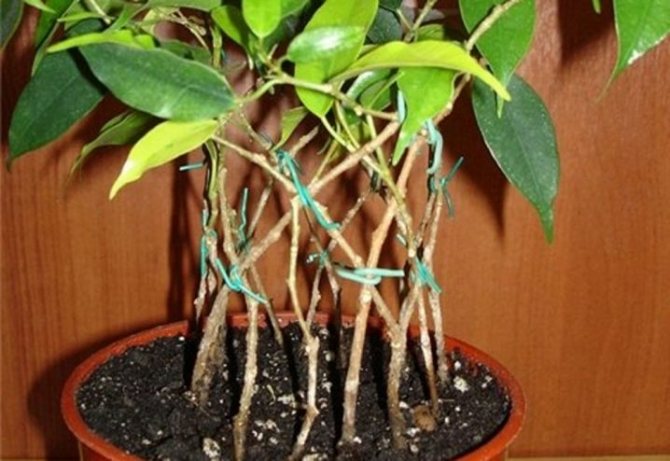

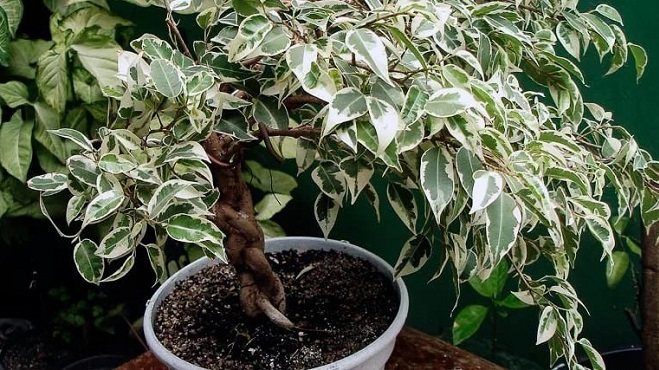

The circular weaving of Benjamin's ficus is also called spiral. This technique is no less attractive than others, therefore, they pay attention to it. Another advantage is that weaving in a circle is much easier than creating a lattice or braid.
If you want to know how to braid Benjamin's ficus, then you need to do everything in the following sequence:
- A strong support should be installed near the cuttings or cuttings.
- As the trunk grows, it will need to be wound around a support in a circle, as it were. In this case, side shoots are superfluous, so do not forget to cut them off in time.
- When the bush stops growing, the support can be removed. One should not rush with this manipulation, because there were cases when the barrel was fed back in such a way that something unusual was obtained. The entire decorative look in this case can be lost.
When the trunks are intertwined, the task can be considered complete. Further, the gardener only has to take care of the flower and admire its beauty.
How to root the shoots?
Shoot rooting can be done in several ways:
- Using a container with warm water. It covers only the nodes of the plant. It is also important to create high humidity, so it is a good option to cover it with a bag or jar.
- Lowering the cuttings into the substrate. Sand or peat can be used as a substrate. It should be sufficiently damp or warm.Immediately before planting a shoot in it, sprinkle the soil with a tablet of activated carbon. The substrate should be moist, but not damp.
- Rooting of aerial shoots. To do this, make 2 cuts between them, and then remove the bark from the tree.
How to make a ficus stem
The central stem needs to be pinned 10-15 centimeters, as a result of which the side shoots begin to grow actively, just do not forget to plant them at the desired height.
You will need a young ficus tree with a formed, vertical, central shoot. Prune side shoots regularly until only 5 top branches remain. When your bole grows to the desired height, pin the top, and cut the side shoots constantly. While the ficus is young and its trunk is not yet stiff enough, you need to support the plant by tying it to a support fixed in the soil.
Try to grow a multi-tiered bole. To do this, divide the crown of the ficus into several parts. For example, you got 5 of them, from the first, third and fifth parts you need to form tier crowns, and the second and fourth parts will be the gaps between these tiers - here the shoots need to be cut off.
Lattice
The lattice is considered a more complicated method of weaving, but, despite this, the beauty of the resulting specimen can be envied. It is worth paying attention to the fact that the classic lattice implies the presence of eight ficuses. True, given that not every territory allows you to buy a large pot and allocate a separate corner for it, you can use any number of plants, but their number should be even.
The steps for creating a lattice are as follows:
- Young shoots are planted in a flowerpot under one line, clearly measuring the distance from one cutting to another. Violation of this nuance will entail a deviation from the norm, and the weaving will no longer look so aesthetically pleasing.
- When the trunks reach a certain height (10-12 cm), they need to be intertwined. For these purposes, cardboard tubes are suitable, which must be installed in the center.
- After a while, young bushes are directed in the direction the gardener wants. The lattice does not have to be even, it can have an unusual bend, which will give the whole structure a special zest. The main thing in this business is imagination, so you should not push it into the background. In order to achieve the desired result, you can use a wire with a winding, which is then easy to remove.
Important! The fixation should not be too strong, so as not to damage the ficus.
Some gardeners create a trellis in a different way. It is simple but original at the same time. For these purposes, you need to take the trunk of a coconut and plant it in the center of the flowerpot. Considering that such a trunk has high humidity, the aerial roots of the ficus will begin to actively develop, quickly intertwining with each other.
Carrying out pruning of ficus
Ficus pruning.
When resorting to the formation of a ficus crown at home, it must be remembered that young plants, whose shoots have not yet become stiff, are more susceptible to intervention. The branches of adult ficuses, as they grow, lose flexibility and are more difficult to form. In addition, it is often necessary to make every effort to awaken the axillary buds on lignified trunks.
In high humidity indoors, adult plants can release aerial roots. They do not always look aesthetically pleasing, but they should not be removed. It is better to direct the roots to the ground, so that the ficus will receive more nutrients.
Before pruning, the following rules must be observed:
- all sections are carried out over the kidney;
- on young and thin processes, the top of the cut is straight;
- on thick and lignified beveled.
The beveled cut begins above the kidney, goes down across the trunk and ends opposite its base.
In order for the crown to have the desired shape, when pruning, it is necessary to focus on the direction of the kidneys.If the branch needs to be directed to the side, the forming bud is the one that is located on the outside of the shoot.
Pruning is done with a sharp knife or pruning shears. All sections are immediately wiped with a clean, damp cloth until the release of whitish juice stops and sprinkled with powdered charcoal or ash. All manipulations must be carried out very carefully in order to prevent infection. It is advisable not to leave stumps in which mold can settle.
Ficus carica (fig) and plant propagation photos
Ficus carica, or fig, or wine berry (Ficus carica L.) belongs to the Mulberry family. Homeland - Mediterranean. A wonderful deciduous ornamental fruit plant. For a room, it is better to take specimens of those varieties in which fruits develop without fertilization.
Ficus carica is easily propagated by cuttings, which quickly take root in sand without shelter or in water. Rooted cuttings are planted in a mixture of greenhouse and compost soil with the addition of sand (2: 2: 1). Indoors, figs are grown as low bushy specimens.
For this, as well as for annual fruiting, the plant must be cut and pinched. Pruning is done in the spring, shortening the branches by 1 / 3-1 / 4. In early June, young shoots are pinched. In the spring and summer, they are kept in bright sunny rooms, watering and feeding abundantly, and they are taken out into the open ground for the summer.
In the autumn-winter period, the fig sheds its leaves. For storage, it is placed in any frost-free, light room, gently watering as needed. Figs overwinter at a temperature of 6-8 ° C. With proper care, it grows and bears fruit in indoor conditions for several years. The fruits ripen on sunny windows.
As you can see in the photo, ficus carica is interesting not only because it gives edible fruits, but it is at the same time an ornamental deciduous plant, suitable in summer for landscaping residential premises, shop windows, etc.:
How to plant?
Ficus Benjamin can be planted with seeds. They are often bought in specialty stores. Before planting, you need to prepare a soil consisting of humus, turf and sand. Bone meal can also be added to create the most comfortable conditions. No seed treatment is required.
As a rule, seeds are planted in the ground to a depth of 5 mm. The container is placed in a bright place, and in order to maintain a high level of humidity, it is placed in a plastic bag.
After the appearance of young shoots, a pick of plants is carried out.
Anti-aging pruning
It is carried out in order to rejuvenate an old tree and return its decorative appeal with a simple rejuvenating procedure. It is also used for an adult plant, which, for example, got into a situation of careless care and, due to lack of watering, began to dry out. Even if most of the branches of the affected ficus are dry, the tree should not be thrown away: such pruning will help "revive" it, because the root system and trunk do not always have time to suffer greatly.
The procedure can be carried out both urgently and routinely. If it is carried out in a planned way (there is a ficus that is not particularly affected, but has an unsightly and "neglected" appearance), it is best to cut the crop in the first months of spring - before the buds that have hatched begin to grow actively.
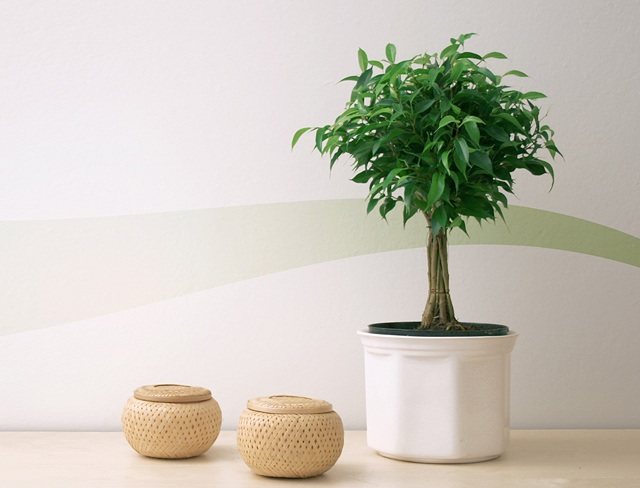

All dead shoots are removed, and the remaining ones should be shortened to half. Places of cuts are sprinkled with coal or ash. In the case when the crown of the tree for some reason completely dried up, the poor sufferer will have to be cut off, making a stump out of it, shortening the trunk as well. The size of the stump should be from seven to ten centimeters. If the tree is properly looked after, it will quickly revive and release new green sprouts from the hemp.
Types of weaving ficus
The most common type of Benjamin ficus weaving is called a spiral.The reason for the popularity of this method of braiding Benjamin's ficus lies in its simplicity and a small number of sprouts. In most cases, a strong support is enough for the stems of the flower, around which the stems are woven.
The most important thing is to remove the side shoots and guide the plant in time. When the spiral from the stems reaches the desired height, the support can be removed from the pot, and the flower will delight with the intertwined trunk. In some cases, a spiral can be made from 4 shoots, but such a trunk will be more of a hassle.

